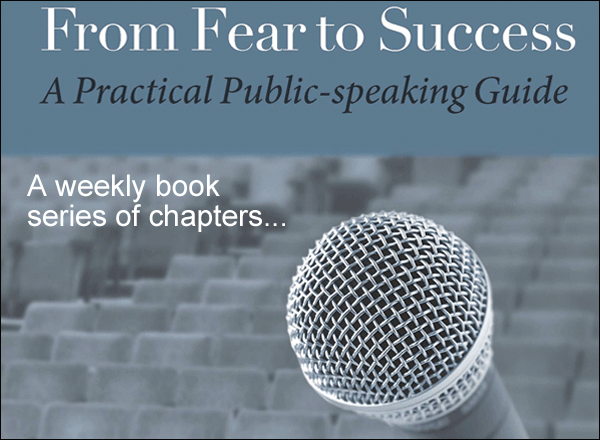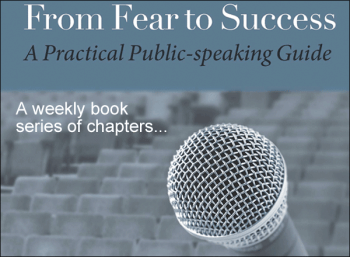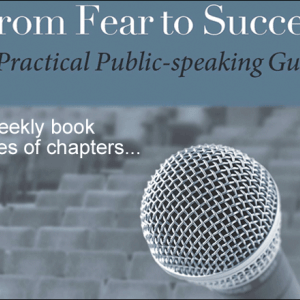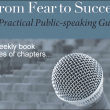Tom Dowd: Road to success, personalize the presentation
Dizzy head. Pounding heart. Shaking limbs. Sweating body. Shallow breathing. Queasy stomach. These symptoms hold people back from what they really want — SUCCESS. Public speakers of all levels will resonate with the concise methods found in "From Fear to Success," an easy-to-read guide to overcome anxiety and relate to any audience on their journey to find their communication confidence.
95. Personalize the Presentation (Audio of this chapter is available here.)
I once watched a presenter attempt to give a salient argument about the dangers of texting and driving. The intended message was to persuade us to practice safe driving and to pass this important message on to others. However, the speaker referenced a local story read out of a newspaper as the focal point of the message. As sad a story as it was when she related the fact that someone had died, the speech felt like it was missing something: the personal touch. I kept asking myself, "How was the speaker connected to the message? Did they have a friend or a family member affected?" I needed to know what made her so passionate about the message.
Not every story needs to be a tear jerker. In fact, I am glad that the speaker was not directly impacted by this example. However, the audience is left guessing when a message does not have the personal appeal that makes it our own. The stories that make up your life will have the greatest impact on any audience because they are unique and new. They will tend to connect genuinely to the hearts and minds of the audience because these stories sincerely come from your heart and mind, with stirring personal emotion, not just emphasized words.
96. Jump in Feet First (Audio of this chapter is available here.)
Ever hear a presentation start with, "How's everyone doing today?" or another generic opening? How about when a significant amount of time is spent listing out things that will be discussed during the event? Have you ever watched the painful beginnings of a presentation when a generic introduction droned on and on? The audience warm-up, in some cases, may become a cool-down where you lose them before you even begin the foundation of your presentation.
Ed Tate, in a presentation at the District 45 2010 Fall Conference talked about jumping immediately into the presentation content. If you had an effective introduction given about you (I hope you wrote it yourself), you should jump right away into the substance, since you should already be set up. The audience is there for the presentation messages, not the generic introductions. Since I started jumping right in, I have found audiences to be more engaged earlier in the presentation because I grabbed their attention from the beginning. A strong introduction is important, and stating what material you will be discussing is important, but the key is to keep the introductions concise and meaningful, and integrate the agenda after the audience is fully engaged.
97.Understand that Learning Is a Process, Not an Event (Audio of this chapter is available here.)
Some gravitational pull may have led you to this book. Whether you felt your stomach drop in an important business presentation or you have a pending proposal you need to make, regardless of the reason, you have dedicated yourself to improving your public speaking. You have taken an exciting step towards your ultimate success.
You should be cautiously optimistic that your journey is just beginning, regardless of your level as a public speaker. Remember that even when your important presentation is over, the public speaking is not. The event may be over, but the process continues. The art of public speaking, and your progress, is ever evolving. The learning process needs constant attention and refinement. It does not happen overnight, but it does happen when you continue to take action. You have already made the tough choice to improve—that was an action. Now, you should make sure that your commitment is strong. Continue to build long-lasting habits that will become your foundation and baseline to work from.
Learning is a process, not an event. Some of you may have some natural ability, and some may not. However, the ability to move forward and improve only happens after you cross over the threshold past the inertia, and then keep your advancement towards success alive.
98. Be Inspirational, Not Loud (Audio of this chapter is available here.)
Have you ever watched an inspirational speaker whose sole ability to inspire seemed to come from his loud voice? As you flip through television channels you are bound to land on a station where someone is trying to sell you something or "inspire you" to give away your money somehow. Much of this is driven through the volume and urgency of the voices saying, "Do it now!" The urgency of the "now" builds the excitement, and that excitement often raises the volume of the speaker. I'm not saying that the loud voices are yelling; they do have a constant tone and pitch that often maintains this sense of urgency through the higher volume.
I have been in situations when I know that the speaker's goal was to motivate or inspire me, but I felt more discomfort—or in some cases boredom— since there was too much constant volume. Many times in these cases, I have found very little vocal variety, so the speech becomes monotonous. In some cases, a speaker's inspirational message is simply about repeating the same words or phrases over and over. Although some repetition is encouraged to ensure the message sticks with an audience, using the same boisterous tone may get old without any vocal variety. I find my mind starting to wander when the loud voice gives me a feeling of being talked at, as opposed to being talked to or talked with.
Inspiration can come from different types of speakers. Many speakers have caught and kept my attention by effectively varying their voice and pitch. Some spend a lot of time in the higher-volume state, and I am all right with that because they periodically bring it down. Most importantly, they have a message that has connected with me and has maintained my attention, not simply because they had a loud voice. Loud may get your attention, but will it maintain that attention?
Whether you are introverted, extroverted, loud, or soft, realize that inspiration can come from all types of speakers. The delivery is one factor to ensure your effectiveness, and having an important message for the audience to take away is another. Have you captured the hearts and minds of the people you are interacting with? You can connect in so many different ways with the audience. Just be confident in knowing that you are connecting.
99. Use Quotations (Audio of this chapter is available here.)
Using quotations can be complex. When, where, and how to effectively incorporate them into your speech can be tough. When it becomes tough, try to determine whether you are forcing it for the sake of a quotation that you like. Ask yourself a few questions: Will the audience like it as much as I do? Does it have a connection to the message I am sending? Is it simple enough to say in a couple of sentences?
I have seen too many speeches in which a quotation was too complex for the simple message being delivered. In some cases, I have heard quotations that were hard for the audience to keep up with. One of my favorite quotations is, "Change is inevitable, growth is optional," by John C. Maxwell. I first saw it taped up in my office. This quotation has stuck with me for many years. It resonates as a strong business quote, especially in an ever-evolving corporate environment. It is simple and easily relatable to many audiences. The impact can be felt in so many places.
The most effective quotations seem to be the most straightforward. "Many people die with the music still in them," by Oliver Wendell Holmes, has its own effortlessness that can be applied in multiple scenarios. Take the audience on a journey with you by using quotations. Make the message memorable and simple—simply make sure the timing is right and that your quotation fits just so. Recognize that quotations should be used to set the tone or reinforce your message. You should try not to jam them into a presentation because you feel obligated. Keep a list of attention-grabbing quotes. Keep a folder of your favorites for future presentations. When you are looking for the right words, go back and reference the folder, to see how a favorite quotation can spice up your presentation.
Note: Whether you are using a quotation, comic strip, music, or anything else that is not your own material, be sure to cite the source and originator for appropriate credit. Please also ensure you are not infringing on copyrights or protected material.
100. Move with Purpose (Audio of this chapter is available here.)
Some speakers wander the stage with what seems like no purpose. They walk back and forth across the front of the stage or simply meander from place to place. This can distract the audience. In fact, early in my speaking career, I paced back and forth to get rid of my nervous energy. This wasn't a bad idea, considering how much my legs would shake, so I wasn't sure if I could stand in one spot, anyway. I was given some feedback recommending that I cut back on some of my movement. I misinterpreted the feedback and stood in the same spot. I no longer distracted the audience, but I appeared even more upright and uptight than when I was pacing. I needed to find a happy medium if I wanted to get my messages across to the audience.
I began to study other speakers' movement. I found out that the effective ones casually walked the stage but were not pacing. They stopped on key points and the movement had a nice, even flow. They always seemed to know how to navigate the stage without distracting the audience or enabling us to predict their every move. The nature of the walk was the fundamental difference. The movement had purpose, but remained as natural as walking down the street. The casual-walk-with-friends approach solved my need to walk the stage to release my nervous energy, and at the same time made me appear as if we were just having a conversation while walking the dog.
101. Use Your Voice as a Tool (Audio of this chapter is available here.)
Your voice has variety, so use it. Whether you are trying to project volume or are making soft-spoken points to reach the hearts of the audience, you can use the full range of what your voice has to offer. I have been watching the growth of one of my Toastmasters club members. In a speech about a scary movie, he described himself, "Screaming like a little girl." When he first started practicing, his squeal was soft and constrained. He was coached to let it all out with a mighty, high-pitched noise. His new approach was uninhibited and achieved his purpose. The audience reacted with a jolt.
You can use various pitches to put yourself in the moment and even use different voices if you are speaking as a character or a third party for further impacts. You don't have to be a full-blown actor or actress to spice up your presentations with different emotions brought to life with your voice. Additionally, you can use pace to your advantage to convey the urgency of a story or slow it down to set the stage for the audience. For example, audience members will almost feel themselves getting exhausted when they hear you breathing heavily as if you have just run a marathon. Use your voice as a tool and watch your own effectiveness soar.
102. Keep It Simple (Audio of this chapter is available here.)
Write speeches that are well-matched with your personality, your education, your style, and your comfort level. I consider myself oversimplified in some cases, and that's the way I like it. When I have attempted to sound smart or use big words, I have found a growing sense of discomfort and unease during the presentation. As speakers, we should make every effort to use descriptive words that paint the picture of what we are trying to say, but our word choice shouldn't deviate too far from who we are normally. Newscasts or effective writing on the Internet intentionally uses shorter sentences with simple words to grab the most attention (funny how I almost used "garner" instead of "grab"—that would have been too ironic). Your credibility comes from people getting to know who you are as a speaker personally. If you start using words that don't typically come from your mouth, they will sound forced and fake, and potentially will hurt the credibility you are working so hard to gain.
103. Share Your Vulnerability (Audio of this chapter is available here.)
We have all had an argument, we have all made mistakes, and we have all been nervous. We all share some common ground, whether it's our background, stories, or situations. When you share those moments, they will resonate instantly with lots of audiences. Many inexperienced speakers are too cautious in their approach to sharing their vulnerabilities and mistakes with the crowd. In my early speaking career, I kept things at a high level; I could have almost been described as vanilla in my early speeches. They were surface only and didn't dive into who I really was. It was only after I started to open my soul and share personal stories that I began to hold the interest of my audiences.
I have seen speakers who have hung on tight to intimate details that would most likely hit home with the audience. I know that these speakers had something poignant to be shared, but it remained bottled up. If the topic made sense, and it was still appropriate to share in order to connect with the audience, why wouldn't they? We are sometimes too self-conscious to let it all out, but your success with the audience almost depends on doing so. You may even find a little therapy for yourself—at least I did. I have obviously included in this book many of the mistakes I have made as a speaker; what you should also see is the journey and learning that followed. Lead your own audience through to your final destination—your take-away message. An effective way to get there is with moving, personal, relatable stories that leave you exposed enough to hit the audience right in their hearts and head.
Related links:
• Chapter 1: Step into the public forum
• Chapter 2: Find the sources of stage fright
• Chapter 4: Understand that success is possible
• Chapters 5-14: Road to success, the anxiety
• Chapters 15-24: Road to success, don't let personality be an excuse
• Chapters 25-34: Road to success, paint the picture
• Chapters 35-44: Road to success, set your stage story
• Chapters 45-54: Road to success, appreciate the audience’s diversity and differences
• Chapters 55-64: Road to success, brainstorm, the friends-and-family effect
• Chapters 65-74: Road to success, grab attention with your opening
• Chapters 75-84: Road to success, use notes — or don’t
• Chapters 85-94: Road to success, be funny, even though I'm not
 Tom Dowd has spoken at many of the Midcoast Rotary, Kiwanis and Lions clubs, is a member of the U.S. National Toboggan Championships Committee, and announcer of the event. He lives in Camden with his wife and three daughters. To read his full biography, click here. He can be contacted at transformationtom.com or tomdowd@roadrunner.com. Follow Tom on twitter: @TomDowd4; connect on Facebook at Thomas Dowd Professional Development & Coaching; and on Linkedin, listed as Thomas B Dowd.
Tom Dowd has spoken at many of the Midcoast Rotary, Kiwanis and Lions clubs, is a member of the U.S. National Toboggan Championships Committee, and announcer of the event. He lives in Camden with his wife and three daughters. To read his full biography, click here. He can be contacted at transformationtom.com or tomdowd@roadrunner.com. Follow Tom on twitter: @TomDowd4; connect on Facebook at Thomas Dowd Professional Development & Coaching; and on Linkedin, listed as Thomas B Dowd.
Event Date
Address
United States


























